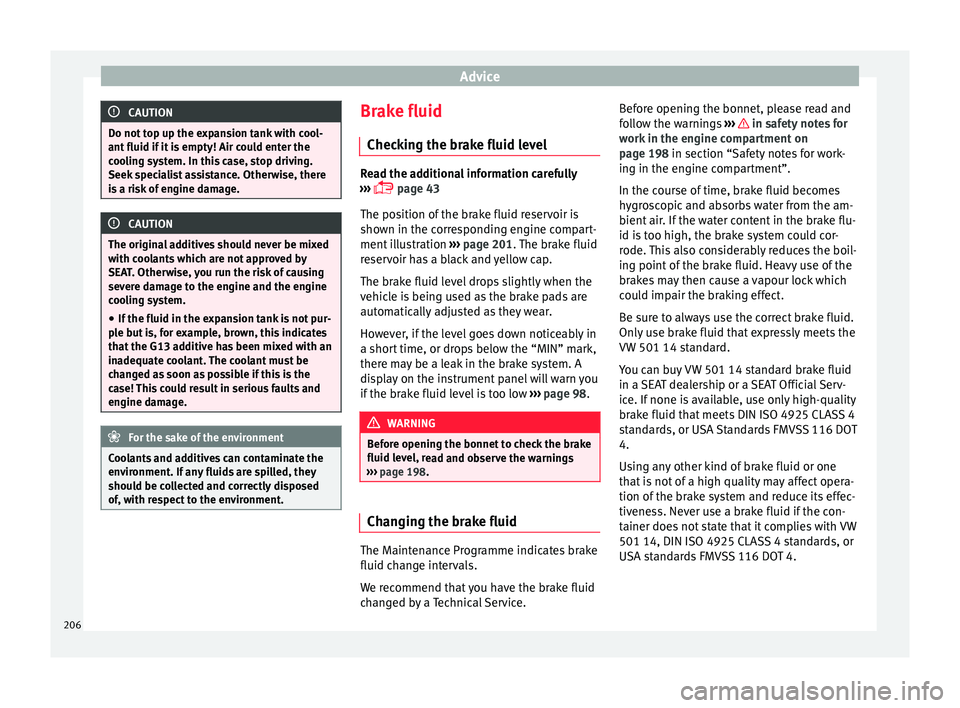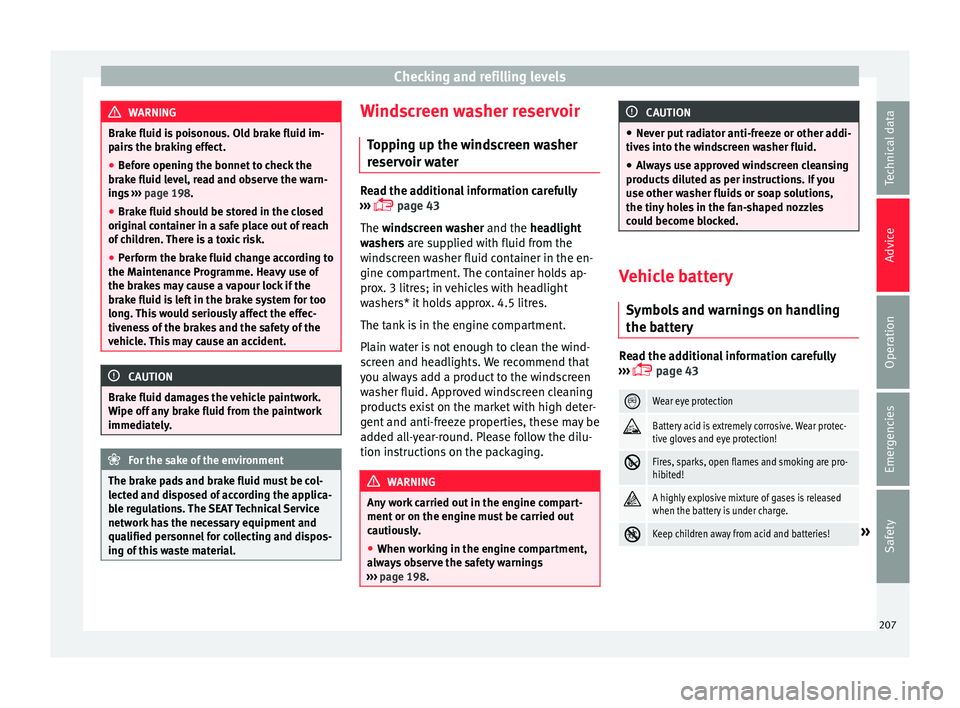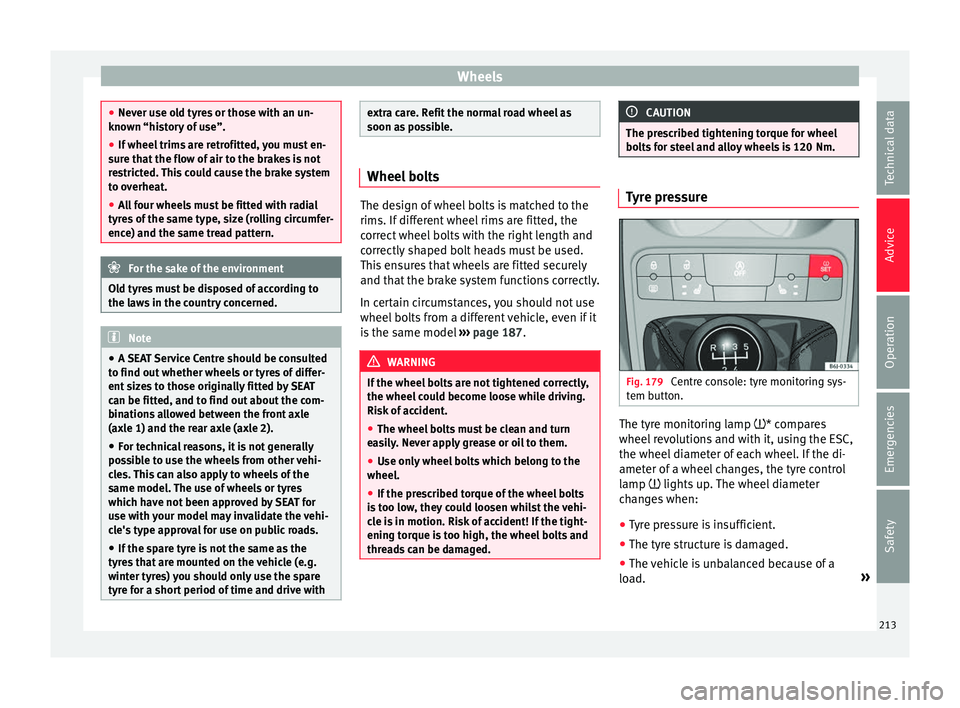2016 Seat Ibiza SC brake light
[x] Cancel search: brake lightPage 208 of 248

Advice
CAUTION
Do not top up the expansion tank with cool-
ant fluid if it
is empty! Air could enter the
cooling system. In this case, stop driving.
Seek specialist assistance. Otherwise, there
is a risk of engine damage. CAUTION
The original additives should never be mixed
with c oo
lants which are not approved by
SEAT. Otherwise, you run the risk of causing
severe damage to the engine and the engine
cooling system.
● If the fluid in the expansion tank is not pur-
ple b
ut is, for example, brown, this indicates
that the G13 additive has been mixed with an
inadequate coolant. The coolant must be
changed as soon as possible if this is the
case! This could result in serious faults and
engine damage. For the sake of the environment
Coolants and additives can contaminate the
env ir
onment. If any fluids are spilled, they
should be collected and correctly disposed
of, with respect to the environment. Brake fluid
Chec k
in
g the brake fluid level Read the additional information carefully
›› ›
page 43
The position of the brake fluid reservoir is
shown in the corresponding engine compart-
ment illustration ››› page 201. The brake fluid
reservoir has a black and yellow cap.
The brake fluid level drops slightly when the
vehicle is being used as the brake pads are
automatically adjusted as they wear.
However, if the level goes down noticeably in
a short time, or drops below the “MIN” mark,
there may be a leak in the brake system. A
display on the instrument panel will warn you
if the brake fluid level is too low ›››
page 98. WARNING
Before opening the bonnet to check the brake
fluid lev el, r
ead and observe the warnings
››› page 198. Changing the brake fluid
The Maintenance Programme indicates brake
fluid c
h
an
ge intervals.
We recommend that you have the brake fluid
changed by a Technical Service. Before opening the bonnet, please read and
fol
low the warnings ››› in safety notes for
w ork
in the en
gine compartment on
page 198 in section “Safety notes for work-
ing in the engine compartment”.
In the course of time, brake fluid becomes
hygroscopic and absorbs water from the am-
bient air. If the water content in the brake flu-
id is too high, the brake system could cor-
rode. This also considerably reduces the boil-
ing point of the brake fluid. Heavy use of the
brakes may then cause a vapour lock which
could impair the braking effect.
Be sure to always use the correct brake fluid.
Only use brake fluid that expressly meets the
VW 501 14 standard.
You can buy VW 501 14 standard brake fluid
in a SEAT dealership or a SEAT Official Serv-
ice. If none is available, use only high-quality
brake fluid that meets DIN ISO 4925 CLASS 4
standards, or USA Standards FMVSS 116 DOT
4.
Using any other kind of brake fluid or one
that is not of a high quality may affect opera-
tion of the brake system and reduce its effec-
tiveness. Never use a brake fluid if the con-
tainer does not state that it complies with VW
501 14, DIN ISO 4925 CLASS 4 standards, or
USA standards FMVSS 116 DOT 4.
206
Page 209 of 248

Checking and refilling levels
WARNING
Brake fluid is poisonous. Old brake fluid im-
pair s
the braking effect.
● Before opening the bonnet to check the
brake fluid l
evel, read and observe the warn-
ings ››› page 198.
● Brake fluid should be stored in the closed
original
container in a safe place out of reach
of children. There is a toxic risk.
● Perform the brake fluid change according to
the Mainten
ance Programme. Heavy use of
the brakes may cause a vapour lock if the
brake fluid is left in the brake system for too
long. This would seriously affect the effec-
tiveness of the brakes and the safety of the
vehicle. This may cause an accident. CAUTION
Brake fluid damages the vehicle paintwork.
Wipe off an
y brake fluid from the paintwork
immediately. For the sake of the environment
The brake pads and brake fluid must be col-
lect ed and di
sposed of according the applica-
ble regulations. The SEAT Technical Service
network has the necessary equipment and
qualified personnel for collecting and dispos-
ing of this waste material. Windscreen washer reservoir
Top
pin
g up the windscreen washer
reservoir water Read the additional information carefully
›› ›
page 43
The windscreen washer and the headlight
washers are supplied with fluid from the
windscreen washer fluid container in the en-
gine compartment. The container holds ap-
prox. 3 litres; in vehicles with headlight
washers* it holds approx. 4.5 litres.
The tank is in the engine compartment.
Plain water is not enough to clean the wind-
screen and headlights. We recommend that
you always add a product to the windscreen
washer fluid. Approved windscreen cleaning
products exist on the market with high deter-
gent and anti-freeze properties, these may be
added all-year-round. Please follow the dilu-
tion instructions on the packaging. WARNING
Any work carried out in the engine compart-
ment or on the en gine mu
st be carried out
cautiously.
● When working in the engine compartment,
alwa
ys observe the safety warnings
››› page 198. CAUTION
● Never p ut
radiator anti-freeze or other addi-
tives into the windscreen washer fluid.
● Always use approved windscreen cleansing
products
diluted as per instructions. If you
use other washer fluids or soap solutions,
the tiny holes in the fan-shaped nozzles
could become blocked. Vehicle battery
Symbo l
s and warnings on handling
the battery Read the additional information carefully
› ›
›
page 43
Wear eye protection
Battery acid is extremely corrosive. Wear protec-
tive gloves and eye protection!
Fires, sparks, open flames and smoking are pro-
hibited!
A highly explosive mixture of gases is released
when the battery is under charge.
Keep children away from acid and batteries!»
207
Technical data
Advice
Operation
Emergencies
Safety
Page 215 of 248

Wheels
●
Never u se o
ld tyres or those with an un-
known “history of use”.
● If wheel trims are retrofitted, you must en-
sure th
at the flow of air to the brakes is not
restricted. This could cause the brake system
to overheat.
● All four wheels must be fitted with radial
tyre
s of the same type, size (rolling circumfer-
ence) and the same tread pattern. For the sake of the environment
Old tyres must be disposed of according to
the l aw
s in the country concerned. Note
● A S EA
T Service Centre should be consulted
to find out whether wheels or tyres of differ-
ent sizes to those originally fitted by SEAT
can be fitted, and to find out about the com-
binations allowed between the front axle
(axle 1) and the rear axle (axle 2).
● For technical reasons, it is not generally
poss
ible to use the wheels from other vehi-
cles. This can also apply to wheels of the
same model. The use of wheels or tyres
which have not been approved by SEAT for
use with your model may invalidate the vehi-
cle's type approval for use on public roads.
● If the spare tyre is not the same as the
tyre
s that are mounted on the vehicle (e.g.
winter tyres) you should only use the spare
tyre for a short period of time and drive with extra care. Refit the normal road wheel as
soon as
po
ssible. Wheel bolts
The design of wheel bolts is matched to the
rims. If diff
er
ent wheel rims are fitted, the
correct wheel bolts with the right length and
correctly shaped bolt heads must be used.
This ensures that wheels are fitted securely
and that the brake system functions correctly.
In certain circumstances, you should not use
wheel bolts from a different vehicle, even if it
is the same model ››› page 187. WARNING
If the wheel bolts are not tightened correctly,
the wheel c ou
ld become loose while driving.
Risk of accident.
● The wheel bolts must be clean and turn
eas
ily. Never apply grease or oil to them.
● Use only wheel bolts which belong to the
wheel.
● If the pr
escribed torque of the wheel bolts
is t
oo low, they could loosen whilst the vehi-
cle is in motion. Risk of accident! If the tight-
ening torque is too high, the wheel bolts and
threads can be damaged. CAUTION
The prescribed tightening torque for wheel
bolt s
for steel and alloy wheels is 120 Nm. Tyre pressure
Fig. 179
Centre console: tyre monitoring sys-
t em b
utt
on. The tyre monitoring lamp * c
omp
ar
es
wheel revolutions and with it, using the ESC,
the wheel diameter of each wheel. If the di-
ameter of a wheel changes, the tyre control
lamp lights up. The wheel diameter
changes when:
● Tyre pressure is insufficient.
● The tyre structure is damaged.
● The vehicle is unbalanced because of a
load. »
213
Technical data
Advice
Operation
Emergencies
Safety
Page 221 of 248

Technical specifications
Engine data P etr
o
l engine 1.0 MPI 55 kW (75 PS)
Power output in kW (PS) at rpmMaximum torque (Nm at rpm)No. of cylinders/displacement (cm 3
)Fuel
55 (75)/6,20095/3,000-4,3003/999Super 95 RON/Normal 91 RON a)
a)
Slight power loss.
Outputs and weightsIBIZAIBIZA
Start-StopIBIZA SCIBIZA SC
Start-Stop
Top speed (km/h)172172172172
Acceleration from 0-80 km/h (seconds)9.59.59.59.5
Acceleration from 0-100 km/h (seconds)14.314.314.314.3
Maximum authorised weight (kg)1,5301,5401,5301,540
Weight in running order (with driver) (kg)1,0431,0491,0431,049
Maximum authorised weight on front axle (kg)790800790800
Maximum authorised weight on rear axle (kg)790790790790
Permitted roof load (kg)75757575
Maximum trailer weight without brakes (kg)520520520520
Weight of trailer with brakes, gradients up to 8% (kg)1,0001,0001,0001,000
Weight of trailer with brakes, gradients up to 12% (kg)800800800800 219
Technical data
Advice
Operation
Emergencies
Safety
Page 222 of 248

Technical data
Petrol engine 1.2 TSI 66 kW (90 PS)Power output in kW (PS) at rpmMaximum torque (Nm at rpm)No. of cylinders/displacement (cm 3
)Fuel
66 (90)/4,400-5,400160/1,400-3,5004/1,197Super 95 RON/Normal 91 RON a)
a)
Slight power loss.
Outputs and weightsIBIZAIBIZA SC
Top speed (km/h)184184
Acceleration from 0-80 km/h (seconds)7.07.0
Acceleration from 0-100 km/h (seconds)10.710.7
Maximum authorised weight (kg)1,5801,580
Weight in running order (with driver) (kg)1,0891,089
Maximum authorised weight on front axle (kg)840840
Maximum authorised weight on rear axle (kg)790790
Permitted roof load (kg)7575
Maximum trailer weight without brakes (kg)540540
Weight of trailer with brakes, gradients up to 8% (kg)1,1001,100
Weight of trailer with brakes, gradients up to 12% (kg)1,0001,000 220
Page 223 of 248

Technical specifications
Petrol engine 1.6 MPI 66 kW (90 PS)Power output in kW (PS) at rpmMaximum torque (Nm at rpm)No. of cylinders/displacement (cm 3
)Fuel
66 (90)/4,250-6,000155/3,800-4,0004/1,598Super 95 RON/Normal 91 RON a)
a)
Slight power loss.
Outputs and weightsIBIZAIBIZA SC
Top speed (km/h)185185
Acceleration from 0-80 km/h (seconds)7.07.0
Acceleration from 0-100 km/h (seconds)10.610.6
Maximum authorised weight (kg)1,5701,570
Weight in running order (with driver) (kg)1,0791,079
Maximum authorised weight on front axle (kg)830830
Maximum authorised weight on rear axle (kg)790790
Permitted roof load (kg)7575
Maximum trailer weight without brakes (kg)530530
Weight of trailer with brakes, gradients up to 8% (kg)1,0001,000
Weight of trailer with brakes, gradients up to 12% (kg)1,0001,000 221
Technical data
Advice
Operation
Emergencies
Safety
Page 224 of 248

Technical data
Petrol engine 1.0 EcoTSI 70 kW (95 PS) Start-StopPower output in kW (PS) at rpmMaximum torque (Nm at rpm)No. of cylinders/displacement (cm 3
)Fuel
70 (95)/5,000-5,500160/1,500-3,5003/999Super 95 RON/Normal 91 RON a)
a)
Slight power loss.
Outputs and weightsIBIZAIBIZA
ecomotiveIBIZA SCIBIZA SC
ecomotive
Top speed (km/h)187191187191
Acceleration from 0-80 km/h (seconds)6.96.96.96.9
Acceleration from 0-100 km/h (seconds)10.410.410.410.4
Maximum authorised weight (kg)1,5901,5901,5901,590
Weight in running order (with driver) (kg)1,0951,0951,0951,095
Maximum authorised weight on front axle (kg)850850850850
Maximum authorised weight on rear axle (kg)790790790790
Permitted roof load (kg)75757575
Maximum trailer weight without brakes (kg)540500540500
Weight of trailer with brakes, gradients up to 8% (kg)10005001000500
Weight of trailer with brakes, gradients up to 12% (kg)900500900500 222
Page 225 of 248

Technical specifications
Petrol engine 1.0 EcoTSI 81 kW (110 PS) Start-StopPower output in kW (PS) at rpmMaximum torque (Nm at rpm)No. of cylinders/displacement (cm 3
)Fuel
81 (110)/5,000-5,500200/2,000-3,5003/999Super 95 RON/Normal 91 RON a)
a)
Slight power loss.
Outputs and weightsIBIZA
ManualIBIZA
AutomaticIBIZA SC ManualIBIZA SC
Automatic
Top speed (km/h)197197197197
Acceleration from 0-80 km/h (seconds)6.36.26.36.2
Acceleration from 0-100 km/h (seconds)9.29.39.29.3
Maximum authorised weight (kg)1,6001,6301,6001,630
Weight in running order (with driver) (kg)1,1091,1401,1091,140
Maximum authorised weight on front axle (kg)860900860900
Maximum authorised weight on rear axle (kg)790780790780
Permitted roof load (kg)75757575
Maximum trailer weight without brakes (kg)550570550570
Weight of trailer with brakes, gradients up to 8% (kg)1,1001,1001,1001,100
Weight of trailer with brakes, gradients up to 12% (kg)1,0001,0001,0001,000 223
Technical data
Advice
Operation
Emergencies
Safety